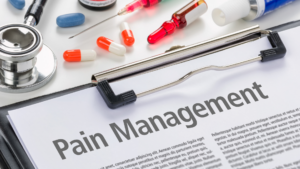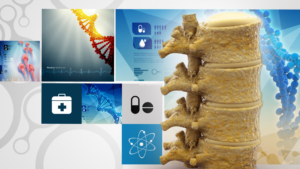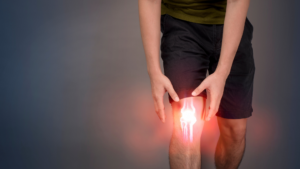We all make New Year’s resolutions – from eating healthier to getting more sleep. However, for those of us living with chronic pain, a different kind of resolution is needed. Living with persistent pain can be emotionally and physically draining, which makes setting realistic goals even more important. Read on to learn how you can start the year by setting achievable resolutions to help manage your chronic pain that could improve your quality of life this new year!

Managing Chronic Pain in the New Year
How Chronic Pain Can Negatively Affect Your Life
Chronic pain can have a significant impact on your day-to-day life. In addition to physical discomfort, it can also affect people emotionally and mentally. For example, chronic pain can lead to feelings of depression, anxiety, and stress.
Therefore, it’s important to be aware of how chronic pain is potentially affecting other aspects of your life to make meaningful changes this year.
Lifestyle Changes and Resolutions for Managing Chronic Pain
Get Enough Sleep
Aim for 7–8 hours each night. Chronic pain can make it difficult to get quality sleep, So it’s essential to create a calming environment and avoid blue screens before bedtime.
Move More
Make sure you’re moving every day. Even if it’s just a few minutes of light stretching, this can help prevent stiffness and improve your range of motion.
Eating Healthy
Eating healthy is vital for everyone, but even more so for people with chronic pain. This includes eating foods that reduce inflammation, like leafy greens, fatty fish, nuts, and seeds.
Reduce Stress
Stress can worsen existing pain, so take some time each day to relax and do something you enjoy. Whether it’s reading a book or listening to music, find something that helps you decompress.
Incorporate Mindfulness
Mindfulness exercises can help manage stress and improve awareness. Try breathing techniques or guided meditation audio tracks that work to bring the body and mind back into balance.
Speak Up
Don’t be afraid to speak up about your chronic pain with your doctor or loved ones. They can offer support, advice, and resources that you may not know about on your own.
Talk to Your Doctor about Alternative Treatments
Acupuncture, massage therapy, TENS machines, and other alternative treatments may be beneficial in managing chronic pain symptoms. So, make sure you speak with your doctor about any options that could work for you.
Get Outside
The benefits of spending time outdoors are endless- from improving mood to boosting energy levels. Plus, getting exposure to sunlight can help naturally boost Vitamin D levels which helps in managing chronic pain.
Make Time for Yourself
The key to managing chronic pain is understanding that self-care is not selfish. Making time for activities you enjoy, whether watching a movie or going for a walk, can help reduce stress and improve overall well-being.
Ways to Prevent Chronic Pain
- Prioritize your activities: Sometimes, it can be difficult to manage chronic pain while also trying to keep up with your obligations. Instead of overwhelming yourself, prioritize the most important tasks and break them down into smaller steps that you can do over time.
- Ask for help: You don’t have to face chronic pain alone; reach out for help from family and friends when needed. They may be able to offer support or provide resources that can help manage your symptoms more effectively.
- Consider counseling: Talking about how pain affects your daily life can help reduce stress and anxiety levels, which are known to increase discomfort levels. If this option is right for you, seek out a qualified mental health professional who can help.
- Stay active: Exercising is an excellent way to manage chronic pain. However, finding an activity that works for your body is essential. Low-impact exercises like yoga or swimming are great options that won’t cause further irritation.
- Track progress: Keeping track of how you feel each day can help you identify patterns and better understand what works best to manage your chronic pain. Writing down moods, symptoms, and activities done throughout the day can give valuable insight into what might be causing flare-ups.
Live a Free Life from Chronic Pain
If you or someone close to you suffers from chronic pain, the New Year is a perfect time to start working on some resolutions. Chronic pain can negatively affect every aspect of your life, from physical activities to mental health. There are things you can do in the New Year to help relieve chronic pain, like stretching and exercising regularly, managing stress levels, getting enough sleep, and eating healthy.
If you need help developing a plan to relief or prevent chronic pain, contact us at Progressive Pain Management. We provide available solutions that work with your body’s needs. Please fill out the form below to get in touch with us.
Since the dawn of time, there is one thing that has remained the same: pain. Humans have always experienced pain, and we always will. There is nothing more useful and treacherous than pain. In a sense, it teaches us what is hot, sharp, poisonous, and alerts our body of injury. But pain is dreadful to deal with on a daily basis.
However, managing pain is still a relatively new topic. The field of pain management has only been around since the 1960s, so it is evolving at record speeds. That’s not to say there haven’t been ways to treat pain, but historically, every method has been temporary or handled in either acute care or pain during death.

The Evolution of Pain Management
The History of Pain Management
In the 1600s, doctors treated patient’s pain by giving them opium. By the 1800s, ether and chloroform were introduced as anesthetics for surgery. This also caused doctors to question the ethics of performing surgery on unconscious patients. Patients, however, thought the use of medication was a godsend. Because patients would be under the influence of these anesthetics for a longer period of time, doctors could not resist the temptation to attempt more complex surgeries and procedures.
In the 1900s, morphine and heroin entered the scene as pain medications. This was also the start of doctor’s worrying about addiction while ultimately wanting to improve their patient’s quality of life.
Chronic pain became a topic worth mentioning, because it was previously treated acutely (injury or post-surgery pain) or relating to death. The idea that recurring pain in patients was an actual condition had been ignored, or the patients were considered delusional. If they refused medication for their pain, patients were referred to psychotherapy or even neurosurgery.
By the 1970s, the field of pain management had been established, with a research journal and association – International Association for the Study of Pain. The concept of interdisciplinary teams were introduced and found to be effective at treating pain. In the 80s, well-known pain management physicians noticed a minor correlation between prescribed opioids and addiction, and pushed for the drugs to be used more in non-cancer pain patients. This lead to doctors prescribing the addictive drugs more liberally and with a backing from leading pharmaceutical companies, doctors did so guilt-free.
“The thing about opioids is they are very effective in interrupting and shutting off pain signals in the brain,” said Marcia Meldrum, a researcher of psychiatry and biobehavioral sciences at UCLA. “They are very, very effective. But they are also very dangerous.”
That didn’t last long. It turned out to be a driving factor in the opioid crisis that we are dealing with today. Many patients still see drugs as being the only way to manage their pain.
The Field of Pain Management
The International Association for the Study of Pain defines pain as “an unpleasant sensory and emotional response associated with actual or potential tissue damage or described in terms of such damage.”
Since the field of pain management was introduced, it has been growing at exponential rates. With this knowledge, research, and advances in technology, a variety of non-medication treatments have emerged.
Pain is processed in six steps – transduction, inflammation, conduction, transmission, modulation, and perception. Understanding these stages is important for physicians to know the best methods of treatment for your pain.
- Transduction – Receptors in the body translate a physical pain or injury to the brain.
- Inflammation – Trauma triggers the damaged cells to release an inflammatory substance that causes the area of pain to become red, swollen, and a lowered pain threshold.
- Conduction – Pain signals are conducted along nerve fibers, which determine the quality of the pain
- Transmission – Where one nerve pathway ends, neurotransmitters transmit the signal between a synaptic gap
- Modulation – This adjustment of pain is performed by an extensive antipain (antinociceptive) system. The limbic system acts as a gatekeeper for pain or stress. When the spinal cord is overstimulated, the body can become hypersensitive to pain.
- Perception – When the pain signals finally reach the brain through the thalamus, they’re directed toward the region of the brain that regulates sensation, autonomic nervous system, motor response, emotion, stress, and behavior. This determines the individual’s perception of pain.
Patients with chronic pain have reduced pain thresholds and therefore feel pain more intensely.
“Pain can make it impossible to live your life. You lose so much quality of life. So for many people, if the solution also means they may become somewhat dependent on a drug, they probably think, ‘Well, that would be better than this,’” said Meldrum. State laws have put a limit on opioid prescriptions so for many patients, they are unable to get their narcotic medications and in search of other ways to reduce their pain.
New Technologies for Treating Pain
New and innovative technology is emerging and thriving in the world of pain management, making it a very exciting time for pain doctors and their patients. Those suffering from chronic pain have options for managing their pain and better access to physicians who can treat them. The ability to treat pain without the use of medication is on the rise, a result of the opioid epidemic.
Neuromodulation is an alteration of the nerve activity by delivering electrical agents to a specific area. It can be used to treat chronic headaches to spinal cord injuries to urinary incontinence. It’s no wonder that with such a vast therapeutic scope, there is major growth in the industry. For each existing neuromodulation treatment, there are dozens of new ones on the horizon. Experimental treatments to relieve pain are being tested and researched.
Stem Cell Therapy is rapidly growing as more research becomes more readily available. Stem cell therapy is harnessing your body’s own cells and systems to effectively treat diseases and conditions. Your own cells are injected to the affected area, assisting in healing damaged tissue, ligaments, and even bone, while minimizing the need for surgery.
The use of Ultrasound in the medical field is not new, but using it for the purposes of pain management is still a relatively new concept for physicians. Ultrasounds have the ability to scan deep structures that aren’t visible on X-Rays. Ultrasound-guided procedures allow physicians to place needles for nerve block injections or other injections with complete accuracy. This allows treatments to be much more effective.
Because technology is moving at rapid speeds, treatments will continue to evolve as the field of pain management grows. Studies are more readily available, physicians are continuing education to remain up-to-date on the latest techniques and conditions, and treatment methods are becoming more and more state-of-the-art thanks to advances in technology. Learn how Progressive Pain Management is adapting to these changes and utilizing the most advanced technology and treatments to help their patients regain mobility, decrease pain, and improve their quality of life.
There are a lot of options for treating pain without the use of narcotics. The opioid epidemic is spreading across the nation at frightening rates. Many state laws are cracking down on opioid prescriptions to prevent excessive prescribing.
However, this leaves many chronic pain patients feeling lost and confused about what options are available. In 2017, New Jersey passed a law that limits the initial opioid prescriptions to 5 days in an effort to reduce opioid misuse and addiction. Chronic pain is a legitimate medical concern.

Non-Opioid Treatments for Chronic Pain
Over-The-Counter Pain Relievers
Taking OTC pain relievers may not be the best way to manage your chronic pain, but will help reduce symptoms on a daily basis. Many doctors prescribe Non-Steroidal Anti-Inflammatory Drugs (NSAIDs) for those suffering from chronic headaches, osteoarthritis, or rheumatoid arthritis because these medications help fight pain and inflammation.
Physical Therapy
Patients who suffer from chronic pain are typically unable to maintain a healthy, active lifestyle. This leads to weakened joints and muscles. Physical therapy helps patients build up to their full potential by using low-intensity therapies like hydrotherapy and ultrasound. Once they get used to that routine and intensity, the focus can shift to more targeted exercises for their specific pain. Physical therapy encourages a higher quality of life and helps patients regain mobility.
Acupuncture
This ancient Chinese form of pain management is most often used to help treat back and neck pain, osteoarthritis, and chronic headaches. The needles stimulate a nerve, signaling the brain to release endorphins that act as a natural opioid. By stimulating the nerve that runs from your brain to your colon, inflammation will lower and often reduce the cause of pain.
High-Tech Methods for Managing Your Chronic Pain
With technology, new methods for treating pain are becoming increasingly popular with doctors and patients.
Radiofrequency Ablations
This process uses heat to reduce pain by eliminating communication to the brain. It’s common in patients who suffer from chronic pain in the lower back, neck, and joints. It provides immediate relief and gets the patient back to a restored quality of life in a shorter amount of time.
Spinal Cord Stimulation
Spinal cord stimulation hides the pain signal before it can reach the brain. A small device is surgically implanted under the skin and sends mild electrical currents to the spinal cord. Pain is reduced due to the stimulation modifying the pain signals and redirecting them away from your brain. Patients may sense a tingling sensation instead of pain.
Nerve Block Injections
With the help of an X-Ray, these injections can dampen or block the pain. Nerve blocks help the pain spread to other body parts, by minimizing the signals sent to the brain. Different types of nerve blocks depend on a patient’s pain. Injections can be used to treat painful conditions, determine the source of pain, or to predict the result of treatment.
Physicians are using these non-opioid treatments instead of writing prescriptions. Other therapies that don’t include medication like exercise therapy and cognitive-behavioral therapies (CBT) are gaining popularity. They focus on changing the patient’s attitude and awareness of their pain and teaching coping mechanisms to manage their pain better.
We Can Help
If you suffer from chronic pain, talk to your doctor about these alternative options for treating pain. Progressive Pain Management can help you find the relief you need. Fill out the form below to get started.
Individuals would be shocked at the number of unnecessary surgeries annually performed in the United States. Unnecessary surgery, by definition, is exactly what it sounds like; “Any surgical intervention that is either not needed, not indicated, or not in the patient’s best interest when weighed against other available options, including conservative measures.” Fortunately, there are easy, effective actions that you can take to avoid going under the knife.

Working with Doctors to Avoid Unnecessary Surgery
Four Ways to Avoid Undergoing Unnecessary Surgery
1. Be educated.
Don’t be afraid to ask your doctor questions to better understand how the recommended procedure will help you in the long run. Will this surgery get rid of your pain? Will this surgery help improve the way your body operates? If the answer to either of these questions is yes, ask them to explain exactly how it will help. The same thing goes for understanding the risks. Be aware of common complications as well as worst-case-scenario situations. Being fully informed will allow you to make the best decision for you. You are your biggest advocate.
2. Know your doctor.
Research your physician and/or surgeon to be sure you are comfortable with the person who is taking care of you. Look into their board certifications, their success rate for the surgery they are presenting to you, and the number of times they have performed the procedure. There is nothing wrong with being certain you are in the best hands and receiving the best care.
3. Consider any alternative treatments.
Not all cases of illness or chronic pain require surgery. Be sure to discuss any and all alternative courses of treatment with your physician. Symptom management or watchful waiting may be the route to go; monitoring your symptoms while holding off on surgery to see if your condition improves, worsens, or remains the same.
4. Prioritize a healthy lifestyle.
You’ve heard this one time and time again and it still rings true. Get moving, even if you’re just taking a daily ten-minute walk. Drink plenty of water. Focus on eating a whole-foods or low-fat diet. Be sure you are getting adequate sleep every night. Modifying your lifestyle to incorporate healthier behaviors ultimately leads to a healthier you.
Understandably, sometimes surgery is the best course of action for patients. However, you should never feel pressured to move forward with any medical treatment you are uncomfortable with. Be educated, know your doctor, consider alternative therapies, and prioritize a healthy lifestyle. These four steps alone may help you, or a loved one, avoid an unnecessary surgery.
The experts at Progressive Pain Management can help manage pain conditions using minimally-invasive techniques and state-of-the-art therapies to help you avoid surgery. Fill out the form below to get started.
There is an ever-growing variety of treatments for those suffering from chronic pain. There is the option of general medicine – oral and topical therapies – that can be used to reduce pain and inflammation. Your doctor may suggest non-medication pain relievers or even use alternative methods like acupuncture.
Physicians will occasionally use interventional techniques involving outpatient procedures or injections of various levels to treat pain. With the recent growth of research, knowledge, and game-changing technology, the amount of treatment options keeps increasing. But not only that, reliable, effective, and safe techniques can be used to manage pain.

Common Treatment Options for Pain
Common Treatment Options to Relieve Chronic Pain
- Exercise
Although rest alleviates pain, too much rest can actually increase pain and increase your risk of further injury. Stay active to help relieve pain from common conditions such as lower back pain, arthritis, and fibromyalgia. Exercise releases endorphins – the body’s natural painkiller – so as you exercise, you are helping your body diminish pain and build strength.
2. TENS
TENS (transcutaneous electrical nerve stimulation) therapy uses a low-voltage electrical current to block pain signals from going to the brain. Electrodes are placed on the skin near the affected area and the electrical stimulation is transmitted into the nerves, blocking “normal” pain signals.
3. Biofeedback
Biofeedback is a machine-assisted technique that measures information about physical characteristics from a patient. It can capture data such as heart rate, brain activity, and body temperature to help enhance the patient’s awareness of how their body reacts to stress and pain. This helps patients learn how to manage physical and emotional pain due to chronic conditions.
4. Yoga
Yoga incorporates a number of relaxation techniques such as breath control, meditation, and strength-training exercises. The combination of these techniques help with chronic pain conditions like arthritis, headaches, back pain, and fibromyalgia. Yoga helps reduce pain that is specific to stress-related conditions. The gentle movements of yoga helps strengthen muscles without putting strain on other parts of the body.
5. OTC Pain Relievers
Over-the-counter pain relievers such as NSAIDs and acetaminophen help relieve mild to moderate pain. The most common medications are Tylenol, Advil, Motrin, and Aleve. NSAIDs reduce inflammation and swelling. Your doctor will be able to suggest which type of OTC medication is best for your chronic pain. Taking pain relievers for long-term relief can cause negative side effects, so be sure to consult with a physician before taking anything.
6. Nerve Block Injections
Nerve block injections are primarily performed as outpatient procedures, but may be used on patients who are already hospitalized for other reasons. Often times, doctors will use contrast dye to determine the most accurate placement of the injection needle. There are a number of different types of injections: epidural steroid injections, facet joint injections, lumbar sympathetic block, celiac plexus block, as well as others.
7. Physical Therapy
Physical therapy helps relieve pain by using specialized movements and techniques. PT helps restore range of motion, improve movement, and normal functions that have been impaired by injury, chronic pain, or a disability. Physical therapists utilize a variety of techniques to provide well-rounded care for their patients including stretching, strength-training, pain-relieving techniques, and sometimes TENS therapy. The goal is to help restore your quality of life and help patients get back to doing what they love.
8. Mind-Body Relaxation Techniques
Mind-body therapies are techniques that are used to train the mind’s ability to positively affect pain and symptoms of the body. Many techniques include relaxation therapies such as meditation, progressive muscle relaxation, breathing exercises, and mindfulness. Training the body to relax and release stress can reduce pain and discomfort from chronic conditions.
9. Therapeutic Massage
Therapeutic massages help manage pain by reducing stress and relieving tension by increasing blood flow. Massages reduce the chemicals in your body that stimulate and sustain pain. Those who suffer from painful muscles, tendons, joints, and chronic back and neck pain can benefit from therapeutic massages. By applying pressure to certain areas on the body, it is possible to impede pain signals to and from the brain, although the effectiveness is still being researched.
Finding treatments that help reduce inflammation and discomfort is important when you live with chronic pain. Regain your quality of life and get back to doing what you love with the help of the experts at Progressive Pain Management. Fill out the form below to start.
There are a lot of options for treating pain without the use of narcotics. The opioid epidemic is spreading across the nation at frightening rates. Many state laws are cracking down on opioid prescriptions to prevent excessive prescribing.
However, many chronic pain patients feel lost and confused about available options. The state of New Jersey passed a law limiting initial opioid prescriptions to 5 days to reduce opioid misuse and addiction. Other states are following suit. Chronic pain is a legitimate medical concern.

Treating Pain Without Opioids
Non-Opioid Treatments for Chronic Pain
Over-The-Counter Pain Relievers
Taking OTC pain relievers may not be the best way to manage your chronic pain, but will help reduce symptoms on a daily basis. Many doctors prescribe Non-Steroidal Anti-Inflammatory Drugs (NSAIDs) for those suffering from chronic headaches, osteoarthritis, or rheumatoid arthritis because these medications help fight pain and inflammation.
Physical Therapy
Patients who suffer from chronic pain are typically unable to maintain a healthy, active lifestyle. This leads to weakened joints and muscles. Physical therapy helps patients reach their full potential using low-intensity therapies like hydrotherapy and ultrasound. Once they get used to that routine and intensity, the focus can shift to more targeted exercises for their specific pain. Physical therapy encourages a higher quality of life and helps patients regain mobility.
Acupuncture
This ancient Chinese form of pain management is most often used to help treat back and neck pain, osteoarthritis, and chronic headaches. The needles stimulate a nerve, signaling the brain to release endorphins that act as a natural opioid. By stimulating the nerve that runs from your brain to your colon, inflammation will lower and often reduce the cause of pain.
High-Tech Methods for Treating Chronic Pain
With technology, new methods for treating pain are becoming increasingly popular with both doctors and patients.
Radiofrequency Ablations
This process uses heat to reduce pain by eliminating communication to the brain. It’s common in patients who suffer from chronic pain in the lower back, neck, and joints. It provides immediate relief and gets the patient back to a restored quality of life in a shorter amount of time.
Spinal Cord Stimulation
Spinal cord stimulation hides the pain signal before it can reach the brain. A small device is surgically implanted under the skin and sends mild electrical currents to the spinal cord. Pain is reduced due to the stimulation modifying the pain signals and redirecting them away from your brain. Patients may sense a tingling sensation instead of pain.
Nerve Block Injections
With the help of an X-Ray, these injections can dampen or block the pain. Nerve blocks help the pain from spreading to other parts of the body, by minimizing the signals sent to the brain. Different types of nerve blocks depend on a patient’s pain. Injections can be used to treat painful conditions, determine the source of pain, or to predict the result of a treatment.
Physicians are using these non-opioid treatments instead of writing prescriptions. Other therapies that don’t include medication like exercise therapy and cognitive-behavioral therapies (CBT) are gaining popularity. They focus on changing the patient’s attitude and awareness of their pain and teaching coping mechanisms to better manage their pain.
Talk to your doctor about alternative treatment options if you suffer from chronic pain. Progressive Pain Management provides a variety of pain management options to help you find relief from your chronic conditions. Fill out the form below to get started.
Spinal cord stimulation therapy is a pain treatment that masks the pain signal before they reach the brain. A device similar to a pacemaker is implanted in the body and delivers electrical pulses to the spinal cord. This is an option for patients with chronic, leg, or arm pain.
What is Spinal Cord Stimulation?
A spinal cord stimulator (SCS) is a small device that is placed under the skin and transmits a mild, low-frequency electric current to the spinal cord. A tiny wire transfers the pulse to the nerve fibers. The SCS minimizes pain because the current modifies and hides the pain signals from reaching the brain.

Spinal Cord Stimulation for Chronic Pain
It is important to note that spinal cord stimulation therapy does not get rid of the source of the pain. It simply runs interference with the signal to the brain. This means that pain relief can vary depending on the patient. The SCS device produces a slight tingling sensation.. It is this sensation that overrides the pain signals. Pain signals travel on the small nerve fibers, whereas the fabricated signals from the SCS travel on larger, more dominant nerves fibers.
The goal of spinal cord stimulation is not to completely erase pain, but to provide a 50-70% reduction. Even the slightest bit of pain relief can be helpful to someone who suffers regularly. Before a permanent spinal cord stimulator is implanted, each patient undergoes a trial to make sure this type of therapy will be effective and reduce their pain.
Why is SCS Used?
Spinal cord stimulation is used to treat neuropathic pain. This is pain that originates from nerve damage. The nerve damage could be caused by injury, accident, or trauma. Patients who are prime candidates for SCS have typically suffered from chronic pain in the lower back, leg, or arm. Commonly, these patients have also had previous surgeries.
More frequently, SCS is being used to avoid back surgery. Other leading causes for receiving SCS therapy is complex regional pain syndrome and peripheral neuropathic pain. Nerve pain that spans beyond damage to the brain and spinal cord, such as from an infection or even amputation or diabetes, is another reason that SCS may be recommended by your physician.
More recently, SCS therapy has been proven to treat a number of chronic visceral pain types, such as abdominal or pelvic pain.
Spinal cord stimulation therapy is used when other treatment types have not been effective in reducing chronic pain or if the patient does not want to undergo surgery. Fortunately, there are no pre-existing medical conditions that would prevent someone from receiving this type of therapy. If you have pain that is caused by a correctable problem (meaning it could be fixed by having surgery or other interventional treatments), SCS is a viable option for reducing your pain.
This type of therapy is more effective when utilized in the earlier stages of a chronic disease or condition, rather than later when a disability has been established.
SCS therapy is used to reduce these types of pain:
- Failed Back Surgery Syndrome: When initial surgery (or surgeries) have been ineffective in reducing pain on a consistent basis.
- Sciatica or Arm Pain: Persistent pain caused by arthritis, spinal stenosis, or extensive nerve damage.
- Complex Regional Pain Syndrome: When patients experience severe chronic pain, typically in their hands or feet.
- Arachnoiditis: This is painful inflammation and scarring of the protective lining of spinal nerves
Other types of pain caused by stump pain, peripheral vascular disease, multiple sclerosis, or a spinal cord injury may be reduced by the use of a spinal cord stimulator.
Benefits of Spinal Cord Stimulation
Spinal cord stimulation therapy reduces the number of abnormal pain signals from reaching the brain. However, it also helps the body restore pain-inhibition pathways that have been lost. Pain-inhibitory pathways essentially work as a gate-keeper. They control how much pain is received by the brain. SCS therapy harnesses the body’s natural pain-relieving chemicals that are used by nerve fibers to communicate with each other. Not only does this whole process reduce pain, but it increases microcirculation.
It is reported that 50-70% of patients who are candidates for SCS therapy experience 50% reduction in pain. An even higher proportion can expect to experience a 30% reduction in pain levels. For many patients who suffer from chronic pain, even the smallest amount of pain relief is welcomed. This has a profound effect on improving the quality of life in patients who have suffered from long-term chronic pain.
Learn more about spinal cord stimulation and how it works for treating chronic pain, fill out the form below and get in touch with the team at Progressive Pain Management today.
Lower extremity pain is commonly due to overuse and inflammation as a result of conditions that affect bones, joints, muscles, tendons, and other organs. The key to pain is understanding what causes it. Only physicians can truly diagnose this kind of pain. There are a few questions to ask when diagnosing pain in your legs, hips, thighs, ankles, and lower joints.
- Is there a recent trauma? Falls to the ground are a common cause for lower extremity pain. This is especially true when a patient is unable to recall periods of time or suffers from a drug withdrawal. There is a chance of fracture, so radiographs should be taken.
- Is the pain articular or non-articular? Articular pain (meaning joint pain) is often accompanied by inflammation or swelling. Non-articular pain is musculoskeletal pain and affects muscles and bones. These differentiating symptoms help physicians diagnose the potential source of the pain.
- What is the root of the pain? When determining and understanding the root of the pain, physicians consider a broad variety of symptoms and characteristics regarding your pain. Things like infection, inflammation, vascular, and neoplastic causes can disguise other sources of pain.

Being able to answer those questions helps pain doctors diagnose pain and recommend effective treatments for lower extremities. The term “lower extremities” includes the pelvis and hip joint, thigh, knee, lower leg, ankle, and feet.
Types of Lower Extremity Pain
Ankle
Because your ankle bears the weight of your entire body, it is prone to injury. The ankle is a complex network of bones, tendons, muscles, and ligaments. This means there are a lot of things that can cause pain.
Ankle pain can be caused by a number of conditions, including, but not limited to:
- Achillies tendonitis
- Gout
- Osteoarthritis
- Plantar Fasciitis
- Sprained Ankle
- Stress Fractures
Thigh
Pain in your thigh commonly starts in nerves that surround the hip and radiate down. Muscle pain, nerve pain, and injuries are all factors to consider when looking at thigh pain.
Pain may be caused by:
- Bernhardt-Roth syndrome
- Overuse
- Sciatica
- Peripheral Neuropathy
- Sprained or torn ligament
- Blood clots
Foot
Foot pain can be caused by overuse and conditions that cause inflammation like injury to tendons or ligaments in the foot. Arthritis is a common cause of foot pain. The bottom of the foot has a network of nerves that when damaged, cause immense burning sensations, numbness, or tingling.
Common causes of foot pain include:
- Osteoarthritis
- Mortnon’s Neuroma
- Plantar Fasciitis
- Gout
- Diabetic Neuropathy
- Tendonitis
Lower Leg
Leg pain can be caused by a wide variety of conditions and injuries. Generally, the leg pain is a cause of tissue inflammation. This can be a result of injury or chronic diseases. The leg contains many different types of tissues and bone structures, making injury and pain very common.
Leg pain can be caused by:
- Shin Splints
- Stress Fractures
- Diabetic Neuropathy
- Peripheral Artery Disease
- Sciatica
- Deep Vein Thrombosis
Hip and Pelvis
Hip and pelvis pain can be difficult to diagnose. The movement of the hip joint, lower back, and leg bones are all connected by a large network of muscles, ligaments, tendons, and joints. Pain from another area of the body frequently causes pain in the hip and pelvis region. This is called referred pain.
Sources of pain can include:
- Bone Fractures
- Arthritis
- Nerve Damage
- Muscle Injury or Inflammation
Knee Joint
If you use your knees to repetitively kneel or lift heavy objects, you may experience knee pain. Knee pain affects people of all ages. Injuries are common and regularly affect the ligaments, tendons, or fluid-filled sacs that surround the bone. Cartilage in the knee also gets damaged from normal wear and tear, which can cause pain.
Common causes for pain include:
- Osteoarthritis
- Meniscal Injuries
- Cysts
- Gout
- ACL tears
- Bursitis
Treatment Options
Once a diagnosis has been made, your physician will create a treatment plan specific to your pain. If the cause is musculoskeletal, non-steroidal medications or acetaminophen may be used. If pain persists, stronger medications may be prescribed, although it is rare that narcotics are needed.
If the pain is articular pain, corticosteroid injections may be used to reduce pain. Muscle and tendon pain can be reduced using physical therapy. However, if the muscle pain is due to arthritis, physical therapy may not be helpful.
Your doctor will work with you to create an effective treatment plan that fits your lifestyle and provides the greatest success in restoring a higher quality of life. The team at Progressive Pain Management can help diagnose the underlying cause of your lower extremity pain and find a relief solution. Fill out the form below to contact the team today.

